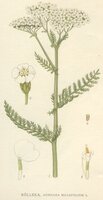Yarrow
|
|
- This page is about the plant named Yarrow. For other uses, see Yarrow (disambiguation).
| Yarrow | ||||||||||||||
|---|---|---|---|---|---|---|---|---|---|---|---|---|---|---|
 Yarrow (Achillea millefolium) | ||||||||||||||
| Scientific classification | ||||||||||||||
|
Yarrow (Achillea millefolium) is a common herb found throughout North America and Europe. It has finely divided, almost feathery leaves, and tiny white or yellow flowers that form a flat-topped cluster. It grows in fields and urban waste places, flowering throughout the summer. Can be planted to combat soil erosion because it is resistant to drought.
The herb is purported to be a diaphoretic, astringent, tonic, stimulant and mild aromatic. It contains isovalerianic acid, salicylic acid, asparagin, sterols, flavonoids, bitters, tannins, and coumarins. The plant also has a long history as a powerful 'healing herb' used topically for wounds, cuts and abrasions. The genus name Achillea is derived from mythical Greek character, Achilles, who reportedly carried it with his army to treat battle wounds. This medicinal action is also reflected in some of the common names mentioned below, such as Staunchweed and Soldier's Woundwort.
The stalks of yarrow are dried and used as a randomising agent in I Ching divination. The flowers of yarrow are sometimes eaten by the larvae of the Lime-speck Pug, Wormwood Pug and Tawny Speckled Pug moths and the leaves by that of the Common Pug and Tawny Speckled Pug.
Yarrow was also used before hops in brewing beer.
Synonyms for Yarrow include Bloodwort, Staunchweed, Nose Bleed, Milfoil, Knight's Milfoil, Old Man's Pepper, Soldier's Woundwort, Herbe Militaris, Thousand Weed, Carpenter's Weed, Sanguinary, Devil's Plaything, Bad Man's Plaything, Devil's Nettle and Yarroway.
The English name Yarrow comes from the Saxon and Dutch words 'Gearwe' and 'Yerw' respectively.
Human uses
As mentioned above, yarrow has seen historical use as a medicine, mainly because of its astringent effects. Decoctions have been used to treat inflammations such as piles (hemorrhoids), and also headaches. It has also been thought to both stop bleeding, as well as promote it. Infusions of Yarrow, taken both internally and externally, are said to speed recovery from severe bruising. The most medicinally active part of the plant are the flowering tops. They also have a mild stimulant effect, and have been used as a snuff. Today, yarrow is valued mainly for its action in colds and influenza, and also for its effect on the circulatory, digestive, and urinary systems.
Yarrow has also been used as a food, and was very popular as a vegetable in the 17th century. The younger leaves are said to be a pleasant leaf vegetable when cooked as spinach, or in a soup. Yarrow is sweet with a slight bitter taste.
The flowers, rich in chemicals are converted by steam into anti-allergenic compounds. The flowers are used for various allergic mucus problems, including hay fever. Harvest during summer and autumn. Drink the infused flower for upper respiratory phlegm or use externally as a wash for eczema. Inhale for hay fever and mild asthma, use fresh in boiling water.
The dark blue essential oil, extracted by steam distillation of the flowers, is generally used as an anti-inflammatory or in chest rubs for colds and influenza. Massage oil for inflamed joints, dilute 5-10 drops yarrow oil in 25ml infused St. John's wort oil. A chest rub can be made for chesty colds and influenza, combine with eucalyptus, peppermint, hyssop, or thyme oils, diluting a total of 20 drops of oil in 25ml almond or sunflower oil.
The leaves encourage clotting, so it can be used fresh for nosebleeds. However, inserting a leaf in the nostril may also start a nosebleed; this was once done to relieve migraines. Harvest throughout the growing season.
The aerial parts are used for phlegm conditions, as a bitter digestive tonic to encourage bile flow, and as a diuretic. The aerial parts act as a tonic for the blood, stimulate the circulation, and can be used for high blood pressure. Also useful in menstrual disorders, and as an effective sweating remedy to bring down fevers. Harvest during flowering. The tincture is used for urinary disorders or menstrual problems. Prescribed for cardiovascular complaints. Soak a pad in an infusion or dilute tincture to soothe varicose veins.
Caution
In rare cases, yarrow can cause severe allergic skin rashes; prolonged use can increase the skin's photosensitivity. Avoid large doses in pregnancy because the herb is a uterine stimulant.
External links
Section Eclectic herbal information
- Achillea millefolium (Yarrow) (http://www.ibiblio.org/herbmed/eclectic/kings/achillea.html) King's American Dispensatory @ Henriette's Herbal
- Yarrow (http://www.botanical.com/botanical/mgmh/y/yarrow02.html) Mrs. Grieve's "A Modern Herbal" @ Botanical.com
Section Herbal information
- Achillea millefolium (Yarrow) (http://www.herbmed.org/herbs/herb13.htm) HerbMed
- Yarrow (http://www.healthy.net/library/books/hoffman/materiamedica/yarrow.htm) Herbalist David Hoffmann @ Health World
Section Pictures
- 'Bilder ur Nordens Flora' (http://caliban.mpiz-koeln.mpg.de/~stueber/lindman/14.jpg)
- 'Flora von Deutschland Österreich und der Schweiz' (http://caliban.mpiz-koeln.mpg.de/~stueber/thome/band4/tafel_121.html)da:Røllike (Achillea millefolium)
de:Gemeine Schafgarbe fr:Achillée millefeuille lt:Paprastoji kraujažolė nl:Gewoon duizendblad pl:Krwawnik pospolity fi:Siankärsämö sv:Röllika

